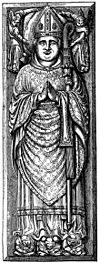William of Wykeham facts for kids
Quick facts for kids William of Wykeham |
|
|---|---|
| Bishop of Winchester | |

William of Wykeham, Bishop of Winchester, 1367-1404: from his tomb at Winchester.
|
|
| Church | Roman Catholic |
| Appointed | 12 July 1367 |
| Reign ended | 27 September 1404 |
| Predecessor | William Edington |
| Successor | Henry Beaufort |
| Orders | |
| Ordination | 1362 |
| Consecration | 10 October 1367 by Simon Langham |
| Personal details | |
| Born | 1320 or 1324 |
| Died | 27 September 1404 |
| Coat of arms |  |
William of Wykeham (born between 1320 and 1324 – died September 27, 1404) was a very important person in medieval England. He was a Bishop of Winchester, which is a high-ranking church leader, and also the Chancellor of England, a top government job.
William is most famous for starting two important schools: New College, Oxford, in 1379, and Winchester College in 1382. He also helped build a lot of Windsor Castle.
Contents
William's Early Life
William of Wykeham was born William Longe. His father, John Longe, was a free man from a town called Wickham in England.
William went to school in Winchester. He got help and support from important local people like Sir Ralph Sutton and Sir John Scures. Later, Thomas Foxley, who was in charge of Windsor Castle, also helped him.
In 1349, William became a church official, a rector, in a place called Irstead. The King chose him for this job.
William the Builder
William became a secretary to the person in charge of Winchester Castle. In this role, he learned a lot about building. This knowledge led him to work for King Edward III.
He helped rebuild parts of Windsor Castle, which was a huge project. William became known for being great at managing and overseeing royal building projects for King Edward III.
By 1356, he was in charge of building royal houses. In October 1356, he became the main supervisor for the big building work at Windsor Castle. He quickly moved up in the King's service.
By 1359, William was the chief keeper and surveyor for many important castles, including Windsor, Leeds Castle, Dover Castle, and Hadleigh Castle. He also managed many royal estates. He was basically the King's main builder and manager. He also took charge of building at Queenborough.
Working for the King
William's career changed in 1361 when he became a royal secretary. This meant he helped manage the King's money. By 1363, he was a royal advisor.
He was present when the Treaty of Brétigny was signed in 1360, which was an agreement between England and France. In 1362, William became a priest. He was paid for his work by receiving income from various churches.
For example, in 1363, King Edward III gave him a church position at Lincoln Cathedral. This was approved by the Pope. By 1366, William held many church positions, earning a lot of money.
Becoming Bishop and Chancellor
William was very talented at managing things. In June 1363, he became the Lord Privy Seal, another important government job. Then, in October 1366, he was chosen to be the Bishop of Winchester.
The Pope approved his appointment in July 1367. He officially became Bishop on October 10, 1367. In the same year, he was also made Chancellor of England, the highest government official under the King.
However, he found it hard to raise enough money for the army fighting France. He lost the King's favor and resigned as Chancellor in 1371.
Staying Important
Even after losing the Chancellor job, William remained important. He kept good relationships with other powerful people like Edward, the Black Prince, the King's son.
In 1376, he was one of four bishops chosen for a new royal council. He had some disagreements with John of Gaunt, another powerful figure. William faced accusations of financial problems and was banned from the King's court.
However, the new King, Richard II, pardoned him in July 1377, shortly after King Edward III died.
Under King Richard II
Under King Richard II, William became a royal advisor again. He even served as Chancellor for a second time, from May 1389 to September 1391.
Founding Schools
After years of helping poor students at Oxford University, William decided to create his own college. He founded New College, Oxford, which received a special permission from the King in 1379.
He also started a school called Winchester College in 1382. This school was meant to prepare students to go to New College. Building work began in Oxford in 1380 and in Winchester in 1387.
William made sure that daily prayers were said at both colleges for King Richard II, his queen, William himself, and his parents and early helpers. He used his wealth from his church jobs and other business dealings to pay for these colleges. He also started rebuilding the main part of Winchester Cathedral in 1394.
By the time Henry IV became king in 1399, William was mostly focused on his schools. He welcomed the new King in Winchester in 1400.
Death and Lasting Impact
William of Wykeham died on September 27, 1404, at Bishop's Waltham. He was buried in his special chapel in Winchester Cathedral.
When he died, he was one of the richest people in England. Much of his money went to the schools he founded. He also left a lot of money to his nephew, whose family still exists today.
William's famous saying was 'Manners makyth man', which means good manners show what kind of person you are. This saying is still the motto of Winchester College and New College, Oxford.
Images for kids


